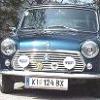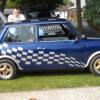I have 12" wheels on the way and disk brakes submitted for the approval process (aka the wife). While I wait for new brakes I would like my drums to be in working order. The rear drums have a bleed valve but the front have a bolt in a similar position. When I turn the bolt it just keeps turning getting tighter and looser as I turn. Is the bolt below the brake line for bleeding?

Brake Bleeding
#1

Posted 25 December 2016 - 12:09 PM
I have 12" wheels on the way and disk brakes submitted for the approval process (aka the wife). While I wait for new brakes I would like my drums to be in working order. The rear drums have a bleed valve but the front have a bolt in a similar position. When I turn the bolt it just keeps turning getting tighter and looser as I turn. Is the bolt below the brake line for bleeding?
#2

Posted 25 December 2016 - 12:15 PM
#3

Posted 25 December 2016 - 01:35 PM
Have a look at the bottom wheel cylinder.
Edited by RedRuby, 25 December 2016 - 01:36 PM.
#4

Posted 25 December 2016 - 05:10 PM
I do not know which year your Mini is. But the bolt seems a kind of strange replacement. For bleeding sequence it is necessary to know the type and year of your Mini The bleed nipple is always at the lowest point on the back of the brake plate.
Brakes - servicing tips
Pad change
"I read a post about levering pistons back in order to change pads. One thing to remember is to open the bleeder so the dirty contaminated fluid goes OUT instead of going back up the brake lines, or you will be rebuilding brake masters sooner than later!"
Bleeding Brakes (task, not exclamation ![]()
"Read the entire brake section of the manual.
To bleed the brakes you need:
- an assistant
- a length of clear hose that is a tightish fit over the bleed nipples
- a clean glass container (jar)
- new brake fluid
- suitable spanners
The idea is:
- open a bleed nipple
- push down the brake pedal to force fluid out
- close the nipple
- release the brake pedal
You must close the nipple first, or air will be sucked back into the system.
Follow the bleeding order in the manual, you should bleed the wheels from furthest away from the master cylinder to the closest one (although some people say the reverse order works too). Locate the bleed nipple (the manual should have a picture) and put the tube on it and put the other end of the tube in the jar. Fill the jar with enough brake fluid to cover the end of the tube.
Open the bleed nipple a 1/2 turn or so and push the pedal down gently to the floor. Fluid should come and go down the hose. Close the bleed nipple and then release the pedal. No fluid should go back into the system.
Repeat.
Make sure you do not run out of brake fluid in the master cylinder. It might be an idea, especially if the fluid is an evil colour, to let the master cylinder go rather empty. Don't let it run out or you will get air in the system and that makes the bleeding job that much harder.
Use DOT4 brake fluid from a new container.
As a general rule do not reuse the fluid that comes out of wheel cylinders.
Bleed all wheels until you get clean fluid coming out; check the master cylinder regularly. You might want to repeat the whole process to make sure you have got all the old fluid out. Do this especially if you have evil coloured fluid.
Make sure all your wheel cylinders are not leaking before you start, or you will have to do the job again when you replace them.
If you can get a pressure bleeder, then follow its instructions. It is MUCH easier, but I've never used a DIY one, only a professional one, which didn't quite fit my master cylinder."
Ed's note: The Gunson Eazibleed is a DIY one-man pressure bleeder, and comes with a number of different master cylinder caps. It's very easy to use and works by pushing the fluid thru from the master cylinder using air from your spare wheel, so make sure that's pumped up before you start ![]()
Bleeding Brakes II
Here's an alternative method which uses one person, no pressure bleeder and no "down!" "down!" "up!" "up!" conversations:
- obtain 4 jam jars or similar containers
- obtain 4 lengths of pipe, inside diameter enough to fit over the bleed nipples and long enough to reach into the jam jars
- clean all 4 nipples (or 6 if you have 4-pots!) and place a piece of pipe over each, into each of the jam jars
- top up the reservoir and leave the cap very loosely on
- slightly open all 4 nipples, just enough for fluid to enter the pipes
- keep topping up the reservoir until each pipe has a constant drip of clean fluid (about 4 times a second)
- tighten the bleed nipples in the order described in the manual (depends on your braking system)
- loosen the first bleed nipple in the order in the manual and allow the fluid to drip in a constant fashion for 20 seconds, ie let the drips become constant, then count 20 seconds (means about 80 drips)
- keep topping up the reservoir - do not let it go below the MIN mark or you'll need to do this all again
- tighten and move to the next nipple in the sequence
- lather, rinse, repeat
In the author's experience, this gives a beautifully firm pedal and can be done just to bleed or indeed to replace the entire fluid throughout the car.
General Service Troubleshooting
Fluid overflow from the top of the reservoir suggests the brakes were serviced (new brake pads) and the fluid had been topped up before the pads were changed
Fluid leaking down the pedal levers is due to an end seal leak, resulting in no brakes and infinite travel
If a plume of fluid is visible in the brake fluid reservoir when the pedal is pushed, there is an internal seal leak, resulting in either no brakes or only one circuit working - infinite or prolonged travel
If the brake pedal pumps up but is soft, there is air in the system and needs to be bled; gives soft but working brakes and long travel
If the pedal travel is long but the pedal is hard at the end of the travel, the rear/front drums need adjusting
If the brake pedal pumps up giving a hard pedal, but needs pumping up again if the car is pushed along the road, there are likely to be loose wheel bearings and/or wobbling discs pushing the calliper pistons back into calliper. You would also feel vibration through the brake pedal, and would need to repeatedly pump the pedal each time it was re-depressed after release.
Pad squeal
The pads are vibrating at high frequency resulting in the squeal. If you apply a smear of copper grease to the BACK on the pad (NOT the friction surface) then the squeal should go away. The pads are probably due for replacement.
Piston sticking
Front offside piston keeps locking on. The problem seems to be that the fluid pressure is very slow to back off after the foot pedal is released.
The piston moves freely when the fluid pressure is released manually - by opening the bleed screw.
This is caused by internal collapsing of the rubber hose; a small piece of rubber on the inside of the flexible pipe breaking away and blocking the pipe, which can cause it to act like a one-way valve - the fluid will go into the calliper, but the flow out is severely restricted. Change the flexible hose.
This can also happen with the rubber clutch hose.
Curing oval drums
"Recently my Mini has developed a bit of ovalness in the rear drums.
I just drove around about 10 mins with the handbrake half on. Left her over night with the hand brake off (in gear). FIXED!"
Edited by Alpenflitzer, 25 December 2016 - 05:20 PM.
#5

Posted 25 December 2016 - 06:19 PM
#6

Posted 25 December 2016 - 08:46 PM
#7

Posted 26 December 2016 - 05:04 PM
Good article, however one can't use a vacuum style bleeder, as the load valve will close, I have used a Gunson easy bleed kit(uses air from tyre)
That is the way I do it - works great with pressure from wheels.
#8

Posted 27 December 2016 - 06:26 PM
#9

Posted 09 January 2017 - 08:26 PM
1 user(s) are reading this topic
0 members, 1 guests, 0 anonymous users

















